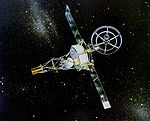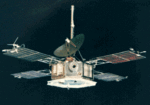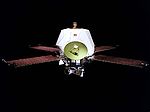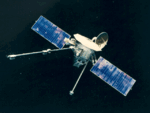- Mariner program
-
 Launch of Mariner 1 in 1962
Launch of Mariner 1 in 1962
The Mariner program was a program conducted by the American space agency NASA that launched a series of robotic interplanetary probes designed to investigate Mars, Venus and Mercury from 1963 to 1973. The program included a number of firsts, including the first planetary flyby, the first pictures from another planet, the first planetary orbiter, and the first gravity assist maneuver.
Of the ten vehicles in the Mariner series, seven were successful and three were lost. The planned Mariner 11 and Mariner 12 vehicles evolved into Voyager 1 and Voyager 2 of the Voyager program, while the Viking 1 and Viking 2 Mars orbiters were enlarged versions of the Mariner 9 spacecraft. Other Mariner-based spacecraft, launched since Voyager, included the Magellan probe to Venus, and the Galileo probe to Jupiter. A second-generation Mariner spacecraft, called the Mariner Mark II series, eventually evolved into the Cassini–Huygens probe, now in orbit around Saturn.
Contents
Basic layout
All Mariner spacecraft were based on a hexagonal or octagonal "bus", which housed all of the electronics, and to which all components were attached, such as antennae, cameras, propulsion, and power sources. All of the Mariners launched after Mariner 2 had four solar panels for power, except for Mariner 10, which had two, and Mariner 2, which was based on the Ranger Lunar probe. Additionally, all except Mariner 1, Mariner 2 and Mariner 5 had TV cameras.
The first five Mariners were launched on Atlas-Agena rockets, while the last five used the Atlas-Centaur. All Mariner-based probes after Mariner 10 used the Titan IIIE, Titan IV unmanned rockets or the Space Shuttle with a solid-fueled Inertial Upper Stage and multiple planetary flybys.
Mariners 1 and 2
Mariner 1 was intended to fly by Venus. The spacecraft was launched on July 22, 1962, but was destroyed approximately 5 minutes after liftoff by the Air Force Range Safety Officer when its malfunctioning Atlas-Agena rocket went off course. Mariner 2 was built as a backup to Mariner 1 and was launched on August 27, 1962, sending it on a 3½-month flight to Venus. The mission was a success, and Mariner 2 became the first spacecraft to have flown by another planet.
- Mission: Venus flyby
- Mass: 203 kg (446 lb)
- Sensors: microwave and infrared radiometers, cosmic dust, solar plasma and high-energy radiation, magnetic fields
Status:
- Mariner 1 – Destroyed shortly after liftoff.
- Mariner 2 – Defunct after successful mission, occupies a heliocentric orbit.
Mariners 3 and 4
Mariner 3 and Mariner 4 were Mars flyby missions. Mariner 3 was lost when the launch vehicle's nose fairing failed to jettison. Its sister ship, Mariner 4, launched on November 28, 1964, was the first successful flyby of the planet Mars and gave the first glimpse of Mars at close range.
- Mission: Mars flyby
- Mass: 261 kg (575 lb)
- Sensors: camera with digital tape recorder (about 20 pictures), cosmic dust, solar plasma, trapped radiation, cosmic rays, magnetic fields, radio occultation and celestial mechanics
Status:
- Mariner 3 – Malfunctioned. Trapped in a Heliocentric orbit.
- Mariner 4 – Unknown. Communications lost after bombardment by micrometeoroids.
Mariner 5
The Mariner 5 spacecraft was launched to Venus on June 14, 1967 and arrived in the vicinity of the planet in October 1967. It carried a complement of experiments to probe Venus' atmosphere with radio waves, scan its brightness in ultraviolet light, and sample the solar particles and magnetic field fluctuations above the planet.
- Mission: Venus flyby
- Mass: 245 kg (540 lb)
- Sensors: ultraviolet photometer, cosmic dust, solar plasma, trapped radiation, cosmic rays, magnetic fields, radio occultation and celestial mechanics
Status: Mariner 5 – Defunct. Trapped in a Heliocentric orbit.
Mariners 6 and 7
Mariners 6 and 7 were identical teammates in a two-spacecraft mission to Mars. Mariner 6 was launched on February 24, 1969, followed by Mariner 7 on March 21, 1969. They flew over the equator and southern hemisphere of the planet Mars.
- Mission: Mars flybys
- Mass 413 kg (908 lb)
- Sensors: wide- and narrow-angle cameras with digital tape recorder, infrared spectrometer and radiometer, ultraviolet spectrometer, radio occultation and celestial mechanics.
Status:
- Mariner 6 – Defunct. Trapped in a Heliocentric orbit.
- Mariner 7 – Defunct. Trapped in a Heliocentric orbit.
Mariners 8 and 9
Mariner 8 and Mariner 9 were identical sister craft designed to map the Martian surface simultaneously, but Mariner 8 was lost in a launch vehicle failure. Its identical sister craft, Mariner 9, was launched in May 1971 and became the first artificial satellite of Mars. It entered Martian orbit in November 1971 and began photographing the surface and analyzing the atmosphere with its infrared and ultraviolet instruments.
- Mission: orbit Mars
- Mass 998 kg (2,200 lb)
- Sensors: wide- and narrow-angle cameras with digital tape recorder, infrared spectrometer and radiometer, ultraviolet spectrometer, radio occultation and celestial mechanics
Status:
- Mariner 8 – Destroyed in a launch vehicle failure.
- Mariner 9 – Shut off. In Areocentric (Mars) orbit until at least 2022 when it will fall out of orbit and into the Martian atmosphere.
Mariner 10
The Mariner 10 spacecraft launched on November 3, 1973 and was the first to use a gravity assist trajectory, accelerating as it entered the gravitational influence of Venus, then being flung by the planet's gravity onto a slightly different course to reach Mercury. It was also the first spacecraft to encounter two planets at close range, and for 33 years the only spacecraft to photograph Mercury in closeup.
- Mission: Venus and Mercury flybys
- Mass: 433 kg (952 lb)
- Sensors: twin narrow-angle cameras with digital tape recorder, ultraviolet spectrometer, infrared radiometer, solar plasma, charged particles, magnetic fields, radio occultation and celestial mechanics
Status: Mariner 10 – Defunct. Trapped in Heliocentric orbit.
Mariner 11 and 12 plans
Originally, a Mariner 11 and Mariner 12 were planned as part of the Mariner program, however, due to congressional budget cuts, the mission was scaled back to be a flyby of Jupiter and Saturn, and renamed the Mariner Jupiter-Saturn probes. As the program progressed, the name was later changed to Voyager, as the probe designs began to differ greatly from previous Mariner missions.[1] The Voyager program launched Voyager 1 and Voyager 2.[1]
References
- ^ a b Chapter 11 "Voyager: The Grand Tour of Big Science" (sec. 268.), by Andrew,J. Butrica, found in From Engineering Science To Big Science ISBN 978-0160496400 edited by Pamela E. Mack, NASA, 1998
See also
- Mariner 11
- Mariner 12
- Mariner Mark II
- Pioneer program
- Tom Krimigis
Mercury Observation 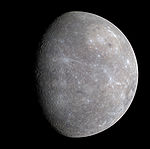
Transits Exploration Properties Geology - Beagle Rupes
- Caloris Basin
- Discovery Rupes
- Rembrandt Basin
- Resolution Rupes
Other topics Mariner program Mariner 1 · Mariner 2 · Mariner 3 · Mariner 4 · Mariner 5 · Mariner 6 and 7 · Mariner 8 · Mariner 9 · Mariner 10Previous mission:
None, see contemporaneous program Pioneer — Next mission:
Voyager programNASA planetary exploration programs Active Explorer · Small Explorer · Voyager · Discovery · New Frontiers · Flagship · Mars Exploration Rover
Completed Pioneer · Mariner · Lunar Orbiter · Ranger · Surveyor · Apollo · Viking · Planetary Observer · Mariner Mark II · MESUR · Mars Surveyor '98 · Mars Scout
Cancelled Categories:- Mars missions
- Mercury spacecraft
- Venus spacecraft
- Mariner program
Wikimedia Foundation. 2010.


